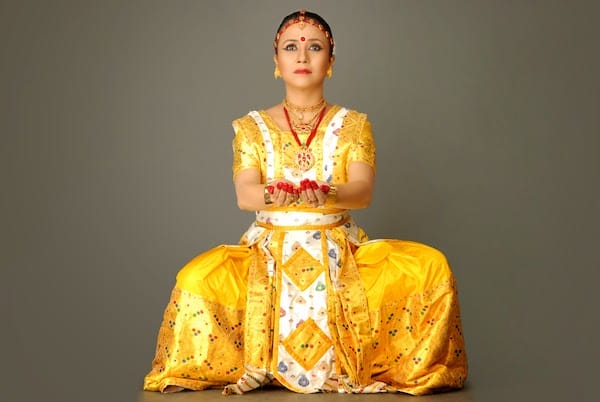TITLE: An Introduction to Sattriya, A Monastic Tradition from NE India with North Penn High School Drama Major Class
AUTHOR AND TEACHER: Andrea Roney
Andrea Roney is a high school drama teacher at North Penn High School in Lansdale, PA.
ARTIST COLLABORATOR: Madhusmita Bora
Madhu Bora is a storyteller, a Sattriya practitioner, an activist, and one of the co-directors of Sattriya Dance Company. (ww.sattriyadancecompany.com)
LENGTH: Multiple 45-minute classes over two months
Find the complete lesson plans in the sidebar under “Downloads.”
Hear the teacher and artist reflect on this set of lessons and the opportunity to work together:
STANDARD(S) ADDRESSED:
National Core Arts Core Standards – Theatre
Creating
- HS Accomplished. Evidence/Conceptualization. TH:Cr1.1.1. a. Apply basic research to construct ideas about the visual composition of a drama/theatre work.
- HS Accomplished. Evidence/Conceptualization. TH:Cr2.1.1. a. Refine a dramatic concept to demonstrate a critical understanding of historical and cultural influences of original ideas applied to a drama/theatre work.
Responding
- High School Accomplished. Reflect. TH: Re7.1.II. a. Demonstrate an understanding of multiple interpretations of artistic criteria and how each might be used to influence future artistic choices of a drama/theatre work.
- High School Advanced. Reflect. TH: Re7.1.III. a. Use historical and cultural context to structure and justify personal responses to a drama/theatre work.
- High School Accomplished. Interpret. TH: Re9.1.II. b. Apply concepts from a drama/theatre work for personal realization about cultural perspectives and understanding.
- High School Advanced. Interpret. TH: Re9.1.III. b. Use new understandings of cultures and contexts to shape personal responses to drama/theatre work
- High School Accomplished. Interpret. TH: Re9.1.II. c. Debate and distinguish multiple aesthetics, preferences, and beliefs through participation in and observation of drama/theatre work.
- High School Advanced. Interpret. TH: Re9.1.III. c. Support and explain aesthetics, preferences, and beliefs to create a context for critical research that informs artistic decisions in a drama/theatre work
- High School Accomplished. Evaluate. TH: Re9.1.II. a. Analyze and assess a drama/theatre work by connecting it to art forms, history, culture, and other disciplines using supporting evidence and criteria.
- High School Advanced. Evaluate. TH: Re9.1.II. a. Research and synthesize cultural and historical information related to a drama/theatre work to support or evaluate artistic choices.

